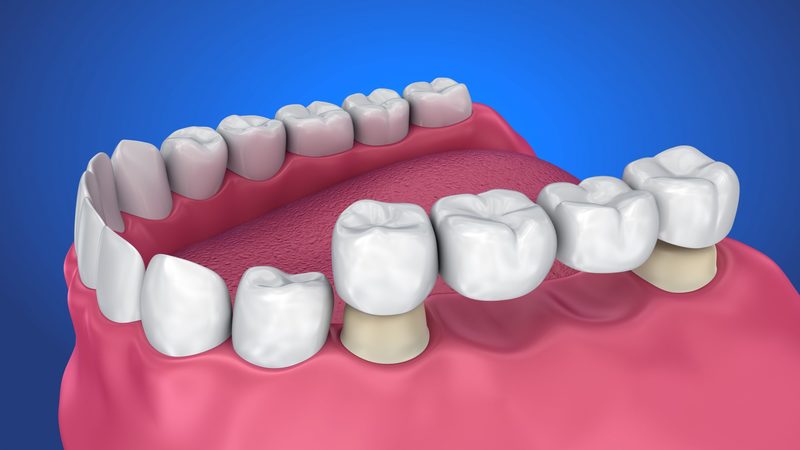What you Need to Know About Dental Bridges

A dental bridge sounds like an intimidating process, but it describes a relatively common procedure and structure. A dental bridge is a way to close existing gaps in the mouth. Gaps between the teeth can be the cause of broken teeth or missing teeth. A dental bridge serves the same function as natural teeth and facilitates chewing.
A Bridge Can Be Used When A Crown Is Not Feasible
Sometimes, a tooth suffers severe decay that limits the feasibility of a dental crown. Imagine a tooth extraction resulting from damage or decay. Another scenario that can require a dental bridge is a dental trauma that displaces the tooth. A dental bridge is an option in such scenarios where a tooth is no longer present. A dental bridge anchors to other structures in the mouth and is possible when a crown is not. Most often, a dental bridge works by anchoring to other crowns. The crowns that serve as anchors can be additions or existing ones.
There are Different Types of Dental Bridges
There is not just one type of dental bridge; the dental bridge is a family with many members.
A traditional dental bridge features two crowns that serve as anchors to help the bridge to keep steady. The bridge is the addition to the mouth supported by the two crowns. A traditional bridge is the most common bridge. A traditional bridge can be permanent or removable, depending upon preference.
A cantilever bridge is different from a traditional bridge because it uses one crown for support. The cantilever bridge is less invasive than a traditional dental bridge. A drawback of a cantilever bridge is that it can cause jaw damage.
A Maryland bridge is even less invasive than a traditional and cantilever bridge. A Maryland bridge attaches to the backs of the teeth and does not require traditional crowns. The Maryland bridge attaches to the back of existing teeth and can be less secure than other dental bridges.
What to Expect During the Dental Bridge Process
Knowing what to expect during the bridge process can take away elements of surprise which can be scary or jarring to a dental patient. For that reason, it is helpful that dental patients know what to expect during the dental bridge process.
First, the dentist will remove any existing decay in the area. Decay is removed through drilling and grinding down the teeth. Once the dentist has a clean canvas, they can continue the procedure.
Next, the dentist will capture images of your decay-free mouth using technology. The captured images will help the dentist create a bridge. Some dentists will fit the mouth with a temporary bridge. A temporary bridge is a short-lasting structure that serves as a placeholder for a permanent bridge. It is crucial that the dentist replaces the temporary bridge with a permanent bridge within a few weeks.
How Long Do Dental Bridges Last?
With proper care, most dental bridges can last for ten years. The best thing a patient can do to promote a long-lasting dental bridge is to engage in proper dental care. Proper dental care includes brushing and flossing twice a day. When you care for your teeth, your dental bridge will last for a longer period of time.
Dental Bridges Require a Period of Adjustment
A dental bridge is not native to your mouth. Therefore, it is common to notice a difference in your bite. A period of dental bridge adjustment occurs and results in your teeth feeling off. Some of the feelings that come with a dental bridge adjustment include tooth sensitivity, soreness when biting down, and changes in speech. As the period of adjustment and acclimation continues, the symptoms should become less severe. Dental bridges require a period of adjustment which averages two weeks.
Dental Bridge Complications
No medical procedure is free from the potential of complications or problems. It is crucial to be knowledgeable about potential complications so that you can remedy them if needed. The addition of a dental bridge can allow a few potential issues and complications.
A dental bridge has the potential to slip and slide. If the dental bridge moves, you will feel the movement. In the event that a dental bridge slips, a new dental bridge may replace the existing dental bridge.
A dental bridge can also become infected or lead to gum disease. A dental bridge makes areas of the mouth more vulnerable. It is essential that patients promote excellent dental hygiene practices because of increased vulnerability.
Although dental bridge complications are not likely, they are possible. Due to the possibility of complications, patients should heed any medical advice. Your dentist will advise you on what foods you can and cannot eat. Following dentist advice will help you avoid complications and promote a long-lasting dental bridge.
A dental bridge is a tool in a dentist’s toolbox that can improve the quality of life. A dental bridge can provide patients with a boost of self-confidence because of cosmetic improvements. A dental bridge also facilitates chewing, an essential part of life. Armed with the knowledge of dental bridges, uses, and recovery, you can now get a dental bridge as an informed consumer. Discuss a dental bridge with your dentist today.

